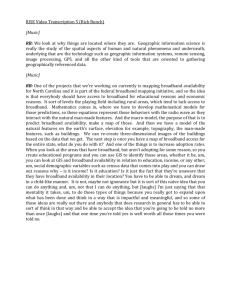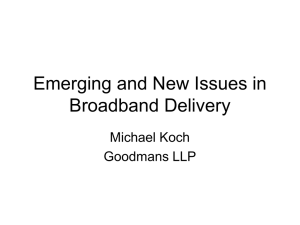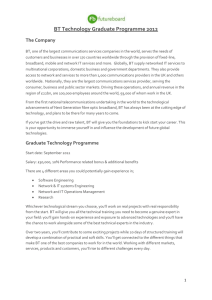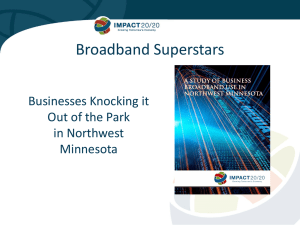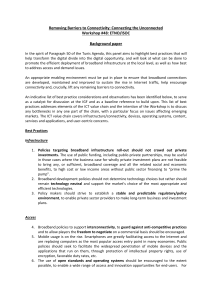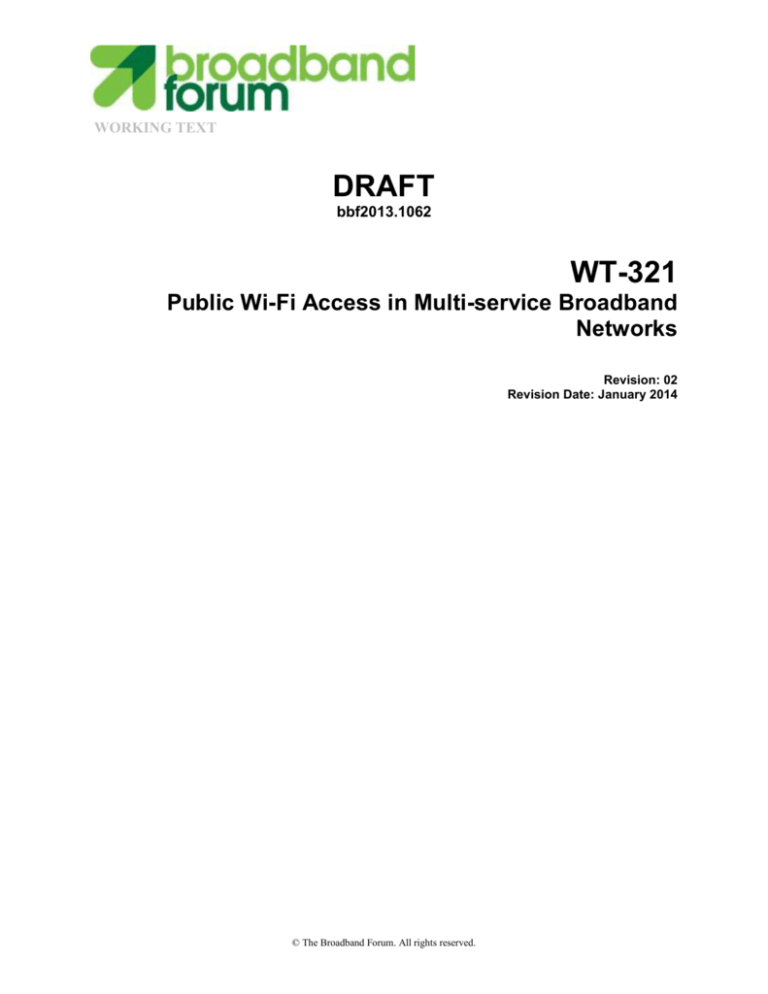
WORKING TEXT
DRAFT
bbf2013.1062
WT-321
Public Wi-Fi Access in Multi-service Broadband
Networks
Revision: 02
Revision Date: January 2014
© The Broadband Forum. All rights reserved.
Working Text Example
WT-210 Revision 062
Notice
The Broadband Forum is a non-profit corporation organized to create guidelines for broadband
network system development and deployment. This Broadband Forum Working Text is a draft, and
has not been approved by members of the Forum. Even if approved, this Broadband Forum
Working Text is not binding on the Broadband Forum, any of its members, or any developer or
service provider. This Broadband Forum Working Text is subject to change. This Broadband
Forum Working Text is copyrighted by the Broadband Forum, and portions of this Broadband
Forum Working Text may be copyrighted by Broadband Forum members. This Working Text is for
use by Broadband Forum members only. Advance written permission by the Broadband Forum is
required for distribution of this Broadband Forum Working Text in its entirety or in portions outside
the Broadband Forum.
This Broadband Forum Working Text is provided AS IS, WITH ALL FAULTS. Any person
holding a copyright in this Broadband Forum WORKING TEXT, or any portion thereof, disclaims
to the fullest extent permitted by law any representation or warranty, express or implied, including,
but not limited to, any warranty:
(A)
OF ACCURACY, COMPLETENESS, MERCHANTABILITY, FITNESS FOR A
PARTICULAR PURPOSE, NON-INFRINGEMENT, OR TITLE;
(B)
THAT THE CONTENTS OF THIS BROADBAND FORUM WORKING TEXT ARE
SUITABLE FOR ANY PURPOSE, EVEN IF THAT PURPOSE IS KNOWN TO THE
COPYRIGHT HOLDER;
(C)
THAT THE IMPLEMENTATION OF THE CONTENTS OF THE WORKING TEXT
WILL NOT INFRINGE ANY THIRD PARTY PATENTS, COPYRIGHTS, TRADEMARKS OR
OTHER RIGHTS.
By using this Broadband Forum Working Text, users acknowledge that there is no obligation upon
Broadband Forum members to license patents that are necessary to implement a Working Text, and
such licensing obligations as may exist with respect to Broadband Forum Technical Reports do not
attach until a proposed Technical Report is finalized by the Broadband Forum.
ANY PERSON HOLDING A COPYRIGHT IN THIS BROADBAND FORUM WORKING
TEXT, OR ANY PORTION THEREOF, DISCLAIMS TO THE FULLEST EXTENT
PERMITTED BY LAW (A) ANY LIABILITY (INCLUDING DIRECT, INDIRECT, SPECIAL,
OR CONSEQUENTIAL DAMAGES UNDER ANY LEGAL THEORY) ARISING FROM OR
RELATED TO THE USE OF OR RELIANCE UPON THIS WORKING TEXT; AND (B) ANY
OBLIGATION TO UPDATE OR CORRECT THIS WORKING TEXT.
The text of this notice must be included in all copies of this Broadband Forum Working Text.
January 20124
© The Broadband Forum. All rights reserved
2 of 30
Working Text Example
WT-210 Revision 062
Revision History
Revision
Number
00
01
02
Revision
Date
March
2013
September,
2013
Revision
Editor
January
2014
Bo Wang
Changes
Purpose, Scope text based on Q4 2012
Osaka Meeting
Updated based on Q3 2013 Atlanta
meeting including:
bbf2013.878.02,
bbf2013.884.02,
bbf2013.888.02.
Updated based on Q4 2013 Rome meeting
including:
bbf2013.1202.01
bbf2013.1203.01
Jianjie You
Bo Wang
Comments or questions about this Broadband Forum Working Text should be directed to:
Jianjie You
ZTE Corporation
Bo Wang
China Telecom
E2EArchitecture
WG Chairs
David Allan
Ericsson
David Thorne
BT
Vice Chair
Sven Ooghe
Alcatel-Lucent
Editor
January 20124
© The Broadband Forum. All rights reserved
3 of 30
Working Text Example
WT-210 Revision 062
Table of Contents
EXECUTIVE SUMMARY ................................................................................................................ 7
1
PURPOSE AND SCOPE ........................................................................................................... 8
1.1
1.2
2
REFERENCES AND TERMINOLOGY ............................................................................... 10
2.1
2.2
2.3
2.4
3
PURPOSE................................................................................................................................ 8
SCOPE.................................................................................................................................... 8
CONVENTIONS ..................................................................................................................... 10
REFERENCES ....................................................................................................................... 10
DEFINITIONS ........................................................................................................................ 11
ABBREVIATIONS .................................................................................................................. 11
WORKING TEXT IMPACT .................................................................................................. 12
3.1
3.2
3.3
3.4
ENERGY EFFICIENCY ........................................................................................................... 12
IPV6 .................................................................................................................................... 12
SECURITY ............................................................................................................................ 12
PRIVACY.............................................................................................................................. 12
4
INTRODUCTION .................................................................................................................... 13
5
USE CASES FOR PUBLIC WI-FI ACCESS ........................................................................ 14
6
PUBLIC WI-FI ACCESS NETWORK ARCHITECTURE ................................................ 15
6.1
PUBLIC WIFI ACCESS NETWORK ARCHITECTURE ............................................................... 15
6.1.1 Architecture 1: AC and BNG are separated ................................................................ 15
6.1.2 Architecture 2: AC and BNG are integrated ................................................................ 16
6.2
INFRASTRUCTURE NETWORK SPECIFICATION ...................................................................... 17
6.3
ACCESS POINT FUNCTION VIRTUALIZATION ....................................................................... 17
7
AUTHENTICATION TECHNOLOGIES ............................................................................. 18
7.1
802.1X AUTHENTICATION ................................................................................................... 18
7.1.1 Scenario 1: AC and BNG are separated, AC is the Authenticator, BNG acts as
RADIUS Proxy ........................................................................................................................... 18
7.1.2 Scenario 2: AC and BNG are separated, AC is the Authenticator, BNG is not as
RADIUS Proxy ........................................................................................................................... 19
7.1.3 Scenario 3: AC and BNG are separated, BNG acts as Authenticator ......................... 22
7.1.4 Scenario 4: AC and BNG are integrated, AC/BNG is the authenticator ..................... 23
7.2
PORTAL AUTHENTICATION .................................................................................................. 25
7.3
MAC AUTHENTICATION ..................................................................................................... 27
8
NODAL REQUIREMENTS.................................................................................................... 28
8.1
8.2
8.3
8.4
8.5
GENERAL REQUIREMENTS ................................................................................................... 28
ACCESS POINT REQUIREMENTS ........................................................................................... 28
ACCESS NODE REQUIREMENTS ........................................................................................... 28
BNG REQUIREMENTS .......................................................................................................... 28
ACCESS CONTROLLER REQUIREMENTS ............................................................................... 29
January 20124
© The Broadband Forum. All rights reserved
4 of 30
Working Text Example
8.6
8.7
WT-210 Revision 062
PORTAL SERVER REQUIREMENTS ........................................................................................ 30
AAA SERVER REQUIREMENTS ............................................................................................ 30
January 20124
© The Broadband Forum. All rights reserved
5 of 30
Working Text Example
WT-210 Revision 062
List of Figures
Figure 1 - Architecture 1a: AC deployed close to the APs ................................................................ 15
Figure 2 - Architecture 1b: AC co-located with BNG ....................................................................... 16
Figure 3 - Architecture 2: AC and BNG integrated ........................................................................... 16
Figure 4 - Scenario 1: AC BNG separated (AC: Authenticator, BNG: RADIUS Proxy) .................. 18
Figure 5 - Scenario 2: AC BNG separated (AC: Authenticator, BNG: not RADIUS Proxy)............ 20
Figure 6 - Scenario 3: AC BNG separated (BNG: Authenticator) ..................................................... 22
Figure 7 - Scenario 4: AC BNG integrated ........................................................................................ 24
List of Tables
No table of figures entries found.
January 20124
© The Broadband Forum. All rights reserved
6 of 30
Working Text Example
WT-210 Revision 062
Executive Summary
Wi-Fi has recently become a ubiquitous access technology available at homes, enterprises and hot
spots. Offloading data traffic from the mobile network using Wi-Fi to the broadband network is the
current trend with the Fixed Mobile Convergence. The Broadband Forum is developing architecture
and solutions for this new access technology.
WT-321 builds on the work done in IETF’s CAPWAP architecture and comes up with a new public
Wi-Fi access network architecture.
January 20124
© The Broadband Forum. All rights reserved
7 of 30
Working Text Example
1
WT-210 Revision 062
Purpose and Scope
1.1 Purpose
Since the introduction of mobile devices that include Wi-Fi, there has been an increasing interest in
improving Broadband Forum’s multi-service broadband architecture to incorporate the public Wi-Fi
access. The rise in the use of smartphones at public hotspots has accelerated this interest. As the
popularity of Wi-Fi enabled devices along with access to Internet and other data services continues
to increase, an emerging ecosystem is taking shape where applications are developed largely
independently of access types. There is increased desire to provide network capabilities that offer
better user experiences and more efficient network utilization for these devices and this is becoming
a requirement for operators that wish to provide superior user experiences.
1.2
Scope
The WT-321 scope includes, use cases, physical and logical architecture and functional and/or
nodal requirements for public Wi-Fi access capabilities that are used nomadically as part of a
broadband network. Architecture includes data, signaling, and management, as well as functional
decomposition and placement into network nodes. Functional and nodal requirements will be
considered for the following: Wi-Fi Access Point (AP), Residential Gateway (RG), CAPWAP
Access Controller (AC), Broadband Network Gateway (BNG). The scope also includes potential
interactions with PDP and/or Authentication Authorization Accounting Server (AAA).
WT-321 covers requirements on:
The potential to simplify Wi-Fi APs by placing some of their current functions (e.g.
authenticator) in a more centralized controller.
Retain the current capability for a single physical AP to host multiple Wi-Fi providers and
services.
Vetting the use of CAPWAP as the protocol supporting centralization of AP control, and
then building upon this or the chosen protocol as necessary.
AP control (including authentication and management) deployed as an overlay over the
broadband access - regardless of type.
Traffic management of AP broadband access supporting both aggregate traffic management
between Wi-Fi service providers and also per-subscriber traffic management.
Support for both co-located and also separated AC and BNG.
Mutual authentication between APs and ACs.
Authentication of attaching devices using the AP or AC as the authenticator.
Security mechanisms including key management.
Reliability mechanisms.
The support of location based services.
Client connection management, including choice of AP.
Interoperability between the AP and AC.
The interface between an AC and broadband network.
January 20124
© The Broadband Forum. All rights reserved
8 of 30
Working Text Example
WT-210 Revision 062
WT-321refers to WT-145, WT-146, WT-178, WT-124i3 and IETF specifications RFC 5415 and
RFC 5416 as appropriate.
January 20124
© The Broadband Forum. All rights reserved
9 of 30
Working Text Example
2
WT-210 Revision 062
References and Terminology
2.1 Conventions
In this Working Text, several words are used to signify the requirements of the specification. These
words are always capitalized. More information can be found be in RFC 2119 [10].
MUST
This word, or the term “REQUIRED”, means that the definition is an
absolute requirement of the specification.
MUST NOT
This phrase means that the definition is an absolute prohibition of the
specification.
SHOULD
This word, or the term “RECOMMENDED”, means that there could
exist valid reasons in particular circumstances to ignore this item, but
the full implications need to be understood and carefully weighed
before choosing a different course.
SHOULD NOT This phrase, or the phrase "NOT RECOMMENDED" means that there
could exist valid reasons in particular circumstances when the
particular behavior is acceptable or even useful, but the full
implications need to be understood and the case carefully weighed
before implementing any behavior described with this label.
This word, or the term “OPTIONAL”, means that this item is one of
an allowed set of alternatives. An implementation that does not
include this option MUST be prepared to inter-operate with another
implementation that does include the option.
MAY
2.2 References
The following references are of relevance to this Working Text. At the time of publication, the
editions indicated were valid. All references are subject to revision; users of this Working Text are
therefore encouraged to investigate the possibility of applying the most recent edition of the
references listed below.
A list of currently valid Broadband Forum Technical Reports is published at
www.broadband-forum.org.
Document
Title
[1]
WT-124i3
Functional Requirements for Broadband
Residential Gateway Devices
[2]
WT-134
Policy Control Framework for DSL
BBF
[3]
WT-146
IP Sessions
BBF
January 20124
© The Broadband Forum. All rights reserved
Source
BBF
Year
10 of 30
Working Text Example
[4]
WT-178
WT-210 Revision 062
Multi-service Broadband Network
Architecture and Nodal Requirements
BBF
[5]
[6]
2011
[7]
2011
[8]
2011
[9]
2010
[10] RFC 2119
Key words for use in RFCs to Indicate
Requirement Levels
IETF
1997
2.3 Definitions
The following terminology is used throughout this Working Text.
2.4 Abbreviations
This Working Text uses the following abbreviations:
AAA
AN
Authentication, Authorization & Accounting
Access Node
BNG
Broadband Network Gateway
EUD
End User Device
TR
RG
Technical Report
Residential Gateway
WG
WLAN
WT
Working Group
Wireless Local Area Network.
Working Text
January 20124
© The Broadband Forum. All rights reserved
11 of 30
Working Text Example
3
WT-210 Revision 062
Working Text Impact
3.1 Energy Efficiency
WT-321 has no impact on energy efficiency.
3.2 IPv6
New considerations need to be given for pair-wise operator interworking where one or the other
operator has migrated or is in the process of migrating to IPv6. For example, if a wireline operator
is using 6rd as a migration path and the wireless operator is using IPv6, then the network elements
involved in interworking may need to be changed or the interworking model may differ.
3.3 Security
TBD.
3.4 Privacy
TBD.
January 20124
© The Broadband Forum. All rights reserved
12 of 30
Working Text Example
4
WT-210 Revision 062
Introduction
This section provides an overview.
January 20124
© The Broadband Forum. All rights reserved
13 of 30
Working Text Example
5
WT-210 Revision 062
Use Cases for Public Wi-Fi Access
January 20124
© The Broadband Forum. All rights reserved
14 of 30
Working Text Example
6
WT-210 Revision 062
Public Wi-Fi Access Network Architecture
This section provides requirements about how the public Wi-Fi architecture is aligned with WT-145
and WT-178 architectural principles.
6.1 Public WiFi Access Network Architecture
6.1.1 Architecture 1: AC and BNG are separated
In this architecture, the AC and BNG are deployed separately as shown in Figure 1 and Figure 2.
A single physical AP can provide multiple SSIDs for different WiFi providers or different services.
For example, enterprise traffic can be offloaded locally via a specific SSID.
There are several deployment assumptions in this architecture:
– AC is responsible for AP management.
– AC is not responsible for IP assignment.
– BNG manages traffic on a per subscriber basis.
– AC can be deployed close to the APs if there are dense APs environment.
– AC can be co-located with BNG.
– AC can communicate with AAA directly, or via RADIUS proxy (e.g. BNG).
– AP needs to support multiple SSIDs.
– Different authentication methods (e.g. 802.1X, Web portal) need to be supported for different
SSIDs.
– Different SSIDs can be used to connect to different service provider or enterprise networks.
AAA
Server
Portal
Server
DHCP
Server
RADIUS Portal DHCP
EUD2
EUD1
AC
AP
BNG
IP MAN
Enterprise
Network
Figure 1 - Architecture 1a: AC deployed close to the APs
January 20124
© The Broadband Forum. All rights reserved
15 of 30
Working Text Example
WT-210 Revision 062
AAA
Server
AC
EUD2
DHCP
Server
RADIUS Portal DHCP
IP MAN
BNG
AP
EUD1
Portal
Server
Enterprise
Network
Figure 2 - Architecture 1b: AC co-located with BNG
6.1.2 Architecture 2: AC and BNG are integrated
In this architecture, the AC is integrated with BNG as shown in Figure 3. A single physical AP can
provide multiple SSIDs for different WiFi providers or different services. For example, enterprise
traffic can be offloaded locally via a specific SSID.
There are several deployment assumptions in this architecture:
– AC is responsible for AP management.
– AC&BNG node manages traffic on a per subscriber basis.
– AP needs to support multiple SSIDs.
– Different authentication methods (e.g. 802.1X, Web portal) need to be supported for different
SSIDs.
– Different SSIDs can be used to connect to different service provider or enterprise networks.
AAA
Server
Portal
Server
DHCP
Server
RADIUS Portal DHCP
EUD2
EUD1
AC&BNG
AP
IP MAN
Enterprise
Network
Figure 3 - Architecture 2: AC and BNG are integrated
January 20124
© The Broadband Forum. All rights reserved
16 of 30
Working Text Example
WT-210 Revision 062
6.2 Infrastructure Network Specification
This section provides the infrastructure network specification based on the architectures mentioned
in section 6.1. This specification includes the public WiFi access network architecture, nodal
requirements and deployment options.
6.3 Access Point Function Virtualization
January 20124
© The Broadband Forum. All rights reserved
17 of 30
Working Text Example
7
WT-210 Revision 062
Authentication Technologies
7.1 802.1X Authentication
7.1.1 Scenario 1: AC and BNG are separated, AC is the Authenticator, BNG
acts as RADIUS Proxy
In this scenario, AC is deployed as the 802.1X authenticator, and BNG is the RADIUS proxy. In the
network, BNG is the service gateway. BNG can be aware of the EUD’s information, and is
responsible for IP address assignment and traffic management on a per subscriber basis. Key
exchange and IP address assignment procedures are initiated after the successful EAP session. An
example of authentication flow for scenario 1 is shown in Figure 5.
AAA
Server
Portal
Server
DHCP
Server
2. EAPoR
EUD2
AC
AP
2. EAPoR
BNG
IP MAN
1. EAPoL
DHCP
Authenticator
RADIUS Proxy
EUD1
Figure 4 - Scenario 1: AC and BNG are separated (AC: authenticator, BNG: RADIUS proxy)
January 20124
© The Broadband Forum. All rights reserved
18 of 30
Working Text Example
EUD
WT-210 Revision 062
AP
AC
BNG
AAA
1. AP authenticated
2. EAPoL-Start
3. EAP-Request/Identity
4. EAP-Response/Identity
5. RADIUS-Access-Request
EAP
Authentication
6. RADIUS-Access-Challenge
7. EAPoL-Exchange
8. RADIUS-Access-Request
9. RADIUS-Access-Accept
10. EAP-Success
Key
Exchange
11. Four-way handshake
12. DHCP Discover
IP address
assignment
13. DHCP Offer/Request/Ack.
14. Accounting Start
Accounting
EUD's traffic
Figure 5 - Example of authentication flows for scenario 1
7.1.2 Scenario 2: AC and BNG are separated, AC is the Authenticator, BNG is
not as RADIUS Proxy
In this scenario, AC is deployed as the 802.1X authenticator, and BNG isn’t the RADIUS proxy. In
the network, BNG is the service gateway.BNG is responsible for IP address assignment, and traffic
management on a per subscriber basis. In this architecture, it is assumed that BNG can obtain
EUD’s authentication information from the AAA. Key exchange and IP address assignment
January 20124
© The Broadband Forum. All rights reserved
19 of 30
Working Text Example
WT-210 Revision 062
procedures are initiated after the successful EAP session. An example of authentication flow for
scenario 2 is shown in Figure 7.
AAA
Server
Portal
Server
DHCP
Server
2. EAPoR
EUD2
AC
AP
BNG
IP MAN
1. EAPoL
DHCP
Authenticator
EUD1
Figure 6 - Scenario 2: AC and BNG are separated (AC: authenticator, BNG: not RADIUS
proxy)
January 20124
© The Broadband Forum. All rights reserved
20 of 30
Working Text Example
EUD
WT-210 Revision 062
AP
AC
AAA
BNG
1. AP authenticated
2. EAPoL-Start
3. EAP-Request/Identity
4. EAP-Response/Identity
5. RADIUS-Access-Request
EAP
Authentication
6. RADIUS-Access-Challenge
7. EAPoL-Exchange
8. RADIUS-Access-Request
9. RADIUS-Access-Accept
10. EAP-Success
Key
Exchange
11. Four-way handshake
12. DHCP Discover
IP address
assignment
13. RADIUS-Access-Request
14. RADIUS-Access-Accept
15. DHCP Offer/Request/Ack.
16. Accounting Start
Accounting
EUD's traffic
Figure 7 - Example of authentication flows for scenario 2
January 20124
© The Broadband Forum. All rights reserved
21 of 30
Working Text Example
WT-210 Revision 062
7.1.3 Scenario 3: AC and BNG are separated, BNG acts as Authenticator
In this scenario, BNG is deployed as the 802.1X authenticator. BNG is responsible for IP address
assignment, and traffic management on a per subscriber basis. AC/AP needs to acquire the PMK
based on 802.11i requirement in the procedure of Key Exchange via RADIUS packets. An example
of authentication flow for scenario 3 is shown in Figure 9.
AAA
Server
Portal
Server
DHCP
Server
2. EAPoR
EUD2
AC
1. EAPoL
AP
DHCP
BNG
IP MAN
Authenticator
EUD1
Figure 8 - Scenario 3: AC and BNG are separated (BNG: authenticator)
January 20124
© The Broadband Forum. All rights reserved
22 of 30
Working Text Example
EUD
WT-210 Revision 062
AP
AC
BNG
AAA
1. AP authenticated
2. EAPoL-Start
3. EAP-Request/Identity
4. EAP-Response/Identity
5. RADIUS-Access-Request
EAP
Authentication
6. RADIUS-Access-Challenge
7. EAPoL-Exchange
8. RADIUS-Access-Request
9. RADIUS-Access-Accept
10. EAP-Success
11. AC acquires PMK
Key
Exchange
12. Four-way handshake
13. DHCP Discover
IP address
assignment
14. DHCP Offer/Request/Ack.
15. Accounting Start
Accounting
EUD's traffic
Figure 9 - Example of authentication flows for scenario 3
7.1.4 Scenario 4: AC and BNG are integrated, AC/BNG is the authenticator
In this scenario, AC is integrated with BNG, as the 802.1X authenticator. Key exchange and IP
address assignment procedures are initiated after the successful EAP session. An example of
authentication flow for scenario 4 is shown in Figure 11.
January 20124
© The Broadband Forum. All rights reserved
23 of 30
Working Text Example
WT-210 Revision 062
AAA
Server
Portal
Server
DHCP
Server
2. EAPoR
EUD2
AC&BNG
AP
IP MAN
1. EAPoL
DHCP
Authenticator
EUD1
Figure 10 - Scenario 4: AC and BNG are integrated
January 20124
© The Broadband Forum. All rights reserved
24 of 30
Working Text Example
WT-210 Revision 062
EUD
AP
AC&BNG
AAA
1. AP authenticated
2. EAPoL-Start
3. EAP-Request/Identity
4. EAP-Response/Identity
5. RADIUS-Access-Request
EAP
Authentication
6. RADIUS-Access-Challenge
7. EAPoL-Exchange
8. RADIUS-Access-Request
9. RADIUS-Access-Accept
10. EAP-Success
Key
Exchange
11. Four-way handshake
12. DHCP Discover
IP address
assignment
13. DHCP Offer/Request/Ack.
14. Accounting Start
Accounting
EUD's traffic
Figure 10 - Example of authentication flows for scenario 4
7.2 Portal Authentication
January 20124
© The Broadband Forum. All rights reserved
25 of 30
Working Text Example
WT-210 Revision 062
7.2.1 Scenario 1: AC and BNG are separated
When AC and BNG are separated, BNG is responsible for IP address assignment and traffic
management on a per subscriber basis. In portal authentication, a pair of username and password
allocated by the operator is considered as a subscriber.
BNG is responsible for redirecting the HTTP traffic of the EUD to the portal server before the EUD
is successfully authenticated. The subscriber needs to input the username and password in the portal
page provided by portal server. After successful authentication, traffic is forwarded in normal
manner.
AAA is responsible for authentication and accounting. Additionally, AAA provides the policy and
QoS configuration of the EUD to the BNG as part of the RADIUS Access Accept message.
Reauthentication may be required after specified period of time or volume quota.
Figure X5 - Scenario 1: AC and BNG are separated (portal authentication)
7.2.2 Scenario 2: AC and BNG are integrated
When AC is integrated with BNG, AC/BNG is responsible for IP address assignment and traffic
management on a per subscriber basis, and redirecting the HTTP traffic of the EUD to the portal
server before the user is successfully authenticated. The subscriber needs to input the username and
password in the portal page provided by portal server. After successful authentication, traffic is
forwarded in normal manner.
AAA is responsible for authentication and accounting. Additionally, AAA provides the policy and
QoS configuration of the EUD to the BNG as part of the RADIUS Access Accept message.
Reauthentication may be required after specified period of time or volume quota.
January 20124
© The Broadband Forum. All rights reserved
26 of 30
Working Text Example
WT-210 Revision 062
Figure X6 - Scenario 2: AC and BNG are integrated (portal authentication)
7.3 MAC Authentication
January 20124
© The Broadband Forum. All rights reserved
27 of 30
Working Text Example
8
WT-210 Revision 062
Nodal Requirements
8.1 General Requirements
8.2 Access Point Requirements
This section provides a set of requirements the AP/RG must fulfill in support of the architecture.
[R-a1] AP MUST be able to support multiple SSIDs.
8.3 Access Node Requirements
This section provides a set of the requirements the Access Node must fulfill in support of the
architecture.
8.4 BNG Requirements
This section provides a set of requirements the BNG must fulfill in support of the architecture.
Table Y1 - BNG requirements for different scenarios of 802.1X authentication
Scenario 1
Scenario 2
Scenario 3
Scenario 4
MUST
MUST
MUST
MUST
MUST
MUST
MUST
MUST
R-b1
R-b2
MUST
R-b3
R-b4
MUST
R-b5
MUST
R-b6
MUST
R-b7
MUST
R-b8
R-b9
MUST
MUST
MUST
R-b10
MUST
MUST
MUST
[R-b1] BNG MUST support 802.1X Authenticator.
[R-b2] BNG MUST support RADIUS proxy.
[R-b3] BNG MUST support RADIUS client.
January 20124
© The Broadband Forum. All rights reserved
28 of 30
Working Text Example
WT-210 Revision 062
[R-b4] BNG MUST proxy the EAPoR packets in order to acquire EUD information (e.g., MAC
address, IMSI) for accounting and management.
[R-b5] Before assigning an IP address to the EUD, BNG MUST confirm that the EUD has been
successfully authenticated.
[R-b6] Upon receiving the DHCP Discover message, BNG MUST initiate the RADIUS Access
Request message based on MAC address to AAA in order to check whether the EUD has been
successfully authenticated.
[R-b7] BNG MUST be able to receive the EUD information (e.g. IMSI) for accounting and user
management from the AAA if the EUD has been successfully authenticated.
[R-b8] BNG MUST transfer PMK (Pairwise Master Key) obtained from AAA to the AC
(Editor’s note: It parked. This requirement depends on finding or creating a standardized way to
do it.)
[R-b9] Upon successful IP address allocation, BNG MUST send the Accounting Start Message to
the AAA.
[R-b10] BNG MUST support 4-way 802.11i handshake with EUD.
8.5 Access Controller Requirements
This section provides a set of requirements the Access Controller (AC) must fulfill in order to
support the architecture.
Table Y2 - AC requirements for different scenarios of 802.1X authentication
Scenario 1
Scenario 2
Scenario 3
R-c1
MUST
MUST
MUST
R-c2
MUST
MUST
MUST
R-c3
MUST
MUST
MUST
Scenario 4
MUST
R-c4
MUST
R-c5
MUST
[R-c1] AC MUST support 802.1X Authenticator.
[R-c2] AC MUST support RADIUS client .
[R-c3] AC MUST support 4-way 802.11i handshake with EUD.
January 20124
© The Broadband Forum. All rights reserved
29 of 30
Working Text Example
WT-210 Revision 062
[R-c4] Before assigning an IP address to the EUD, AC MUST confirm that the EUD has been
successfully authenticated.
[R-c5] Upon successful IP address allocation, AC MUST send the Accounting Start Message to the
AAA.
8.6 Portal Server Requirements
This section provides a set of requirements the Portal Server must fulfill in order to support the
architecture.
8.7 AAA Server Requirements
This section provides a set of requirements of the AAA (Authentication, Authorization and
Accounting) Server must fulfill in order to support the architecture.
Table Y3 - AAA requirements for different scenarios of 802.1X authentication
Scenario 1
Scenario 2
Scenario 3
Scenario 4
R-d1
MUST
MUST
MUST
MUST
R-d2
MUST
MUST
MUST
MUST
MUST
MUST
R-d3
R-d4
MUST
MUST
MUST
[R-d1] AAA MUST support 802.1X Authentication Server.
[R-d2] AAA MUST send the policy and QoS configuration (e.g., bandwidth, time/traffic quota) to
the RADIUS client (AC or BNG) for the EUDs successfully authenticated.
[R-d3] Upon receiving the RADIUS Access Request message with the MAC address of the EUD
from BNG, AAA MUST send the corresponding EUD information to BNG in the RADIUS Access
Accept message.
[R-d4] AAA MUST support storage of the EUD information.
End of Broadband Forum Working Text WT-321
January 20124
© The Broadband Forum. All rights reserved
30 of 30



